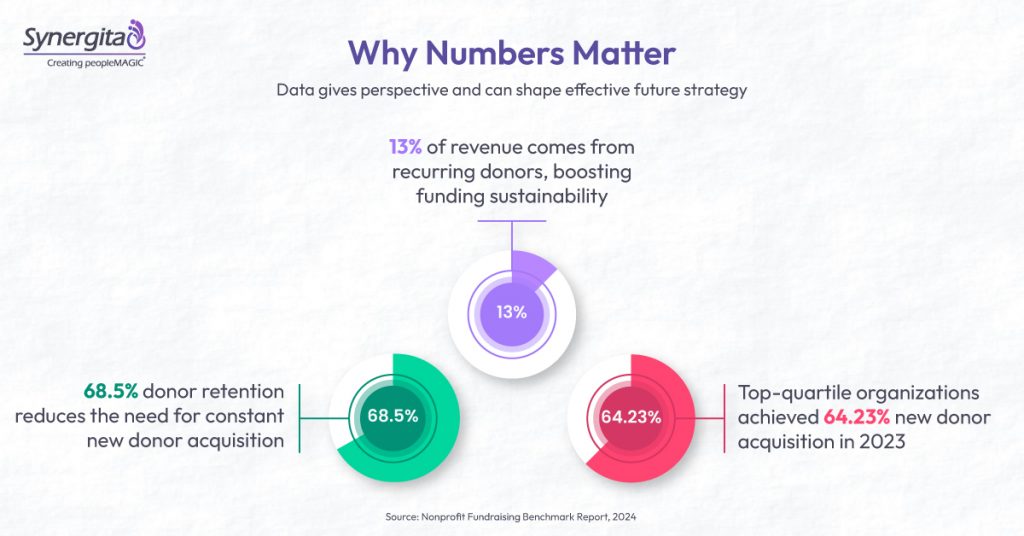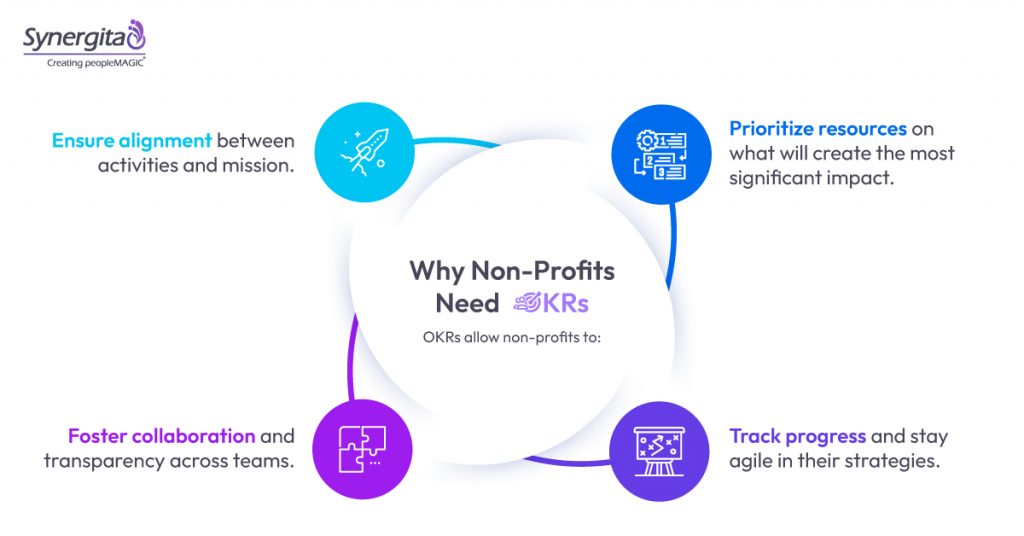Philanthropy hinged on hard data may sound cold, but the reality is most funding decisions are based on benefit-cost ratios, ROI, and rigorous performance evaluations. These numbers are more than benchmarks; they are the foundation of trust and accountability. For funders, metrics confirm that their investments drive impact, while for grantees, these evaluations provide the insights needed to refine and elevate their work. Together, this data-driven approach ensures that every dollar spent is maximized for meaningful change.
Non-profits often operate in high-stakes environments with limited resources, making every action and decision crucial. Success isn’t measured by profit margins but by how well an organization meets its mission.
Here, Objectives and Key Results (OKRs) can be a powerful framework to align teams, prioritize resources, and drive meaningful outcomes, making non-profit work both efficient and impactful.

In this blog, we’ll explore how OKRs help non-profits maintain focus on their mission, improve transparency, and maximize their limited resources. We’ll also include specific examples and a real-world scenario to illustrate the practical application of OKRs in a non-profit setting.
Why Non-Profits Need OKRs
For non-profits, it’s easy to get lost in daily activities, spread thin across too many projects, or become reactive to emerging issues, all of which can dilute their core mission. OKR Software help non-profits maintain focus by setting clear objectives that align with their mission and tracking specific, measurable outcomes. This structure empowers non-profits to make data-informed decisions, improving accountability across teams.

Implementing OKRs in Your Non-Profit
Each of these OKR examples illustrates a clear pathway for non-profits to align their activities with their mission and track progress.
To implement OKRs successfully, non-profits should:
- Set Realistic Objectives: Each objective should be mission-aligned and realistically achievable.
- Define Measurable Key Results: Key results should be specific, quantifiable, and time-bound.
- Review and Adapt: Regular reviews ensure that OKRs remain relevant and achievable, allowing teams to make adjustments as needed.
10 OKR Examples for Non-Profits
These OKRs cover core areas like program delivery, fundraising, community engagement, and operational efficiency. For each example, we’ve included a clear objective aligned with a mission-driven goal and a set of measurable key results to track progress.
1. Expand Program Reach to Marginalized Communities
Non-profits often aim to reach new communities where their impact can be most significant. This OKR focuses on broadening program accessibility.
Objective: Expand our literacy program to reach new underserved areas.
- KR 1: Partnerships with 15 local schools in remote communities by the end of Q2.
- KR 2: Increase the number of enrolled students by 30% by Q3.
- KR 3: Hire and train 20 new field volunteers within six months.
2. Improve Donor Retention and Engagement
Consistent funding is crucial for non-profits, making donor retention a key priority. This OKR ensures that donors stay engaged and continue their support.
Objective: Boost donor retention and build long-term relationships.
- KR 1: Increase annual donor retention rate from 60% to 75%.
- KR 2: Launch a quarterly newsletter for donor updates, achieving a 40% open rate.
- KR 3: Host two virtual “Donor Appreciation” events by year-end.
3. Increase Awareness and Visibility
Expanding a non-profit’s reach requires raising awareness among new audiences. This OKR is designed to increase visibility through digital and community channels.
Objective: Raise awareness about our mission and programs.
- KR 1: Grow social media followers by 25% across all platforms by Q3.
- KR 2: Achieve 50 media mentions or blog features by the end of the year.
- KR 3: Organize three outreach events, engaging at least 500 new individuals.
4. Enhance Volunteer Engagement and Retention
Volunteers are essential to many non-profits. Keeping them motivated and involved is key to sustaining program success.
Volunteers are essential to many non-profits. Keeping them motivated and involved is key to sustaining program success.
Objective: Improve volunteer engagement and retention rates.
- KR 1: Implement a quarterly recognition program for top volunteers.
- KR 2: Increase volunteer retention from 50% to 70% by year-end.
- KR 3: Conduct two training workshops for skill development each quarter.
5. Increase Funding to Support Core Initiatives
Non-profits need a steady influx of funding to operate effectively. This OKR aims to diversify and increase funding sources.
Objective: Increase funding from diverse sources to support our mission.
- KR 1: Secure grants from five new foundations by Q2.
- KR 2: Launch a crowdfunding campaign to raise $50,000 by Q3.
- KR 3: Partner with three corporations for sponsorships by year-end.
6. Improve Program Quality and Outcomes
For non-profits that deliver services, maintaining high program quality is critical. This OKR focuses on delivering impactful, quality programs that meet the needs of beneficiaries.
Objective: Enhance the quality and impact of our literacy programs.
- KR 1: Develop and pilot a new curriculum in three schools by Q1.
- KR 2: Achieve a 90% program satisfaction rate among students and teachers.
- KR 3: Track and report on literacy progress, aiming for a 15% improvement in reading levels by year-end.
7. Optimize Operational Efficiency
Operational efficiency can help non-profits make the most of limited resources. This OKR is aimed at streamlining processes to reduce costs and improve productivity.
Objective: Increase operational efficiency to maximize resource utilization.
- KR 1: Reduce overhead costs by 10% through process improvements by Q4.
- KR 2: Implement a new project management tool for team coordination by Q2.
- KR 3: Decrease administrative time spent on reporting by 30% through automation.
8. Develop Strong Partnerships for Resource Sharing
Partnerships can open up new resources and networks, helping non-profits extend their reach and effectiveness.
Objective: Build and leverage partnerships to expand resources and impact.
- KR 1: Formalize partnerships with five community organizations by Q2.
- KR 2: Coordinate three joint initiatives to serve 500 beneficiaries collectively.
- KR 3: Secure $30,000 in shared resources through partnerships by year-end.
9. Strengthen Data Collection and Impact Measurement
Data-driven decision-making allows non-profits to better demonstrate their impact and improve accountability. This OKR focuses on enhancing data practices.
Objective: Improve data collection and reporting to measure program impact effectively.
- KR 1: Implement a digital tool for data collection across all field offices by Q2.
- KR 2: Train 100% of program staff in data collection and reporting protocols.
- KR 3: Publish an annual impact report showcasing key metrics by Q4.
10. Boost Beneficiary Satisfaction and Engagement
Ensuring that beneficiaries are satisfied and engaged helps non-profits understand the needs and preferences of the communities they serve.
Objective: Increase beneficiary engagement and satisfaction with programs.
- KR 1: Conduct quarterly feedback sessions, achieving a 75% satisfaction rate.
- KR 2: Develop a digital survey tool for anonymous feedback.
- KR 3: Implement two new services based on beneficiary feedback by the year-end.
Adapting OKRs to Mission-Driven Work
OKRs offer more than a framework—they serve as a blueprint for achieving meaningful change.
Here are a few key takeaways for non-profits adopting OKRs:
- Align OKRs with Mission: Every objective should reflect the mission, ensuring all resources and activities contribute to a meaningful outcome.
- Measure Impact with Clear Key Results: Specify quantitative targets that allow for measurable success. For instance, “Provide 5,000 books by Q3” creates a clear and trackable target.
- Review and Adjust Regularly: Non-profits often face shifting needs. Regular OKR check-ins ensure adaptability, so the organization can stay responsive to the communities they serve.
- Foster Transparency: OKRs promote clarity and accountability, empowering every team member to understand how their work supports the organization’s goals.
Path Forward for Non-Profits
OKRs enable non-profits to act with purpose, navigate limited resources, and remain focused on creating social impact. By setting clear objectives and measuring key results, non-profits can maximize their potential and drive transformative change.
For organizations, the adoption of OKRs means that every step taken brings them closer to their mission of improving literacy in underserved areas. In a world where resources are finite, OKR tools help non-profits do more with less, ensuring their work leaves a lasting impact. Synergita OKR Management Software brings structure to your organization with ease and helps you build a stronger community with the power of progress tracking. Try Synergita OKR , The Best OKR Software in the Market and see the difference!
